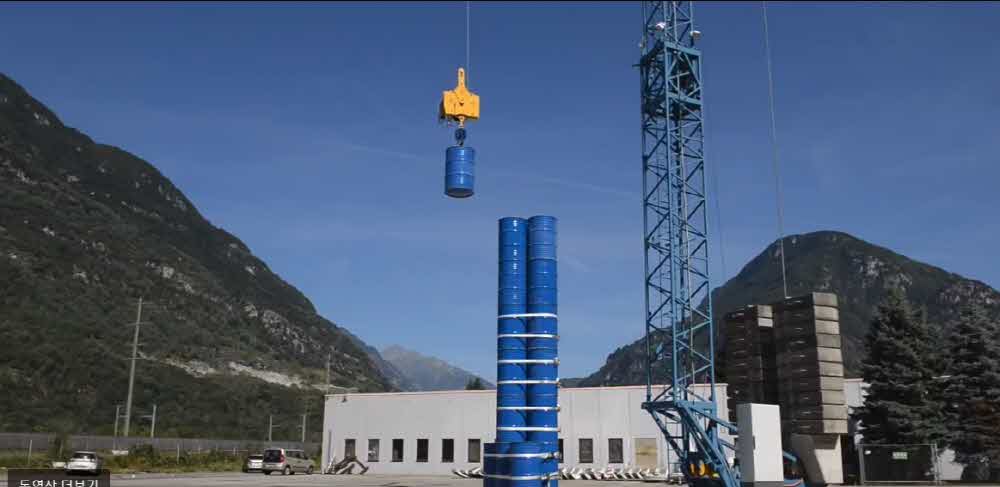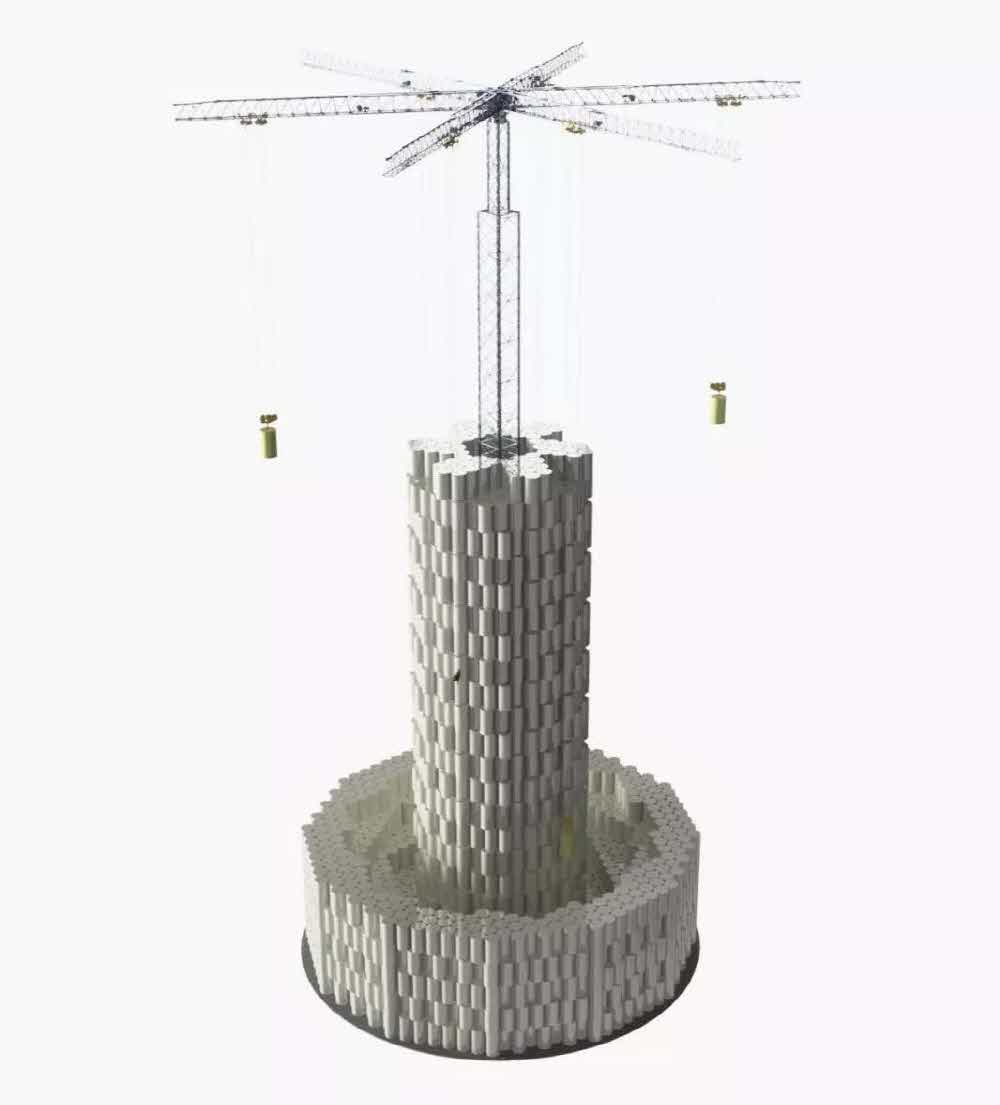Electricity is sent to homes through distribution facilities such as wires. Of course, if demand for electricity increases, there is a risk of not being able to supply electricity. For this reason, it is also possible to utilize a hydropower hydropower system that utilizes a drop to lift the lower reservoir to a temporarily higher position. When the demand for electricity is high, a dam is created to flow water from a high place to a low place. Then, when the demand is reduced, the water is raised again from a low place to a high place to save energy for electric power demand.

However, for amphibious hydropower, terrain constraints must be addressed. Two reservoirs are needed, which increases construction costs. But the Swiss startup Energy Vault has developed a concrete battery as an alternative to this problem.
The structure of the concrete battery developed by Energy Bolt is actually no different from the hydroelectric power generation described above. It is different from using concrete blocks and cranes instead of water and dams. Concrete batteries are used to build blocks of concrete instead of water used in hydropower, and when the demand for electricity exceeds a certain level, concrete blocks that have been stacked are lowered to the floor by crane. The drop energy generated when the block is dropped on the floor is used as power.
One of the biggest advantages of concrete batteries is power efficiency. The most energy efficient of the batteries so far has been able to produce 90% of the charge through lithium-ion batteries. Concrete batteries generate 85% of the power required to transport the block to the ground. It is said that it has energy efficiency similar to lithium ion battery.
The concrete battery built by the energy bolt demonstration can not produce much power because it is composed of one crane to load and lower the concrete block at 20m height. But according to EnergyVault’s plan, the concrete battery to be built will reach 120m in height and 6 cranes. With this facility, the amount of power that can be generated is up to 20mW per hour. That’s about 2,000 households in Switzerland can supply the electricity they need every day.
One of the other advantages of concrete batteries is the low cost of power supply. A lithium ion battery for power generation costs between $ 280 and $ 350 per kW, but a concrete battery is estimated at $ 150. A half is enough.

Concrete is much cheaper than lithium-ion batteries, which is advantageous in terms of the cost of building the facility. Concrete used in blocks can save material costs by recycling materials from construction works.
Concrete battery technology is nothing new in hardware itself. But the software is different. When the concrete block is lifted by the crane, the block shakes due to the influence of the wind and the block consumes unnecessary power in this process. The energy bolt side has implemented a crane control program that minimizes the effects of the wind and allows it to be less affected by a little wind.
Of course, there is no problem with concrete batteries. The cost of power supply is low right now, but lithium-ion batteries are expected to cost as little as $ 10 per kW in the future. Therefore, it will be necessary to consider ways of lowering the power supply cost in terms of energy bolts.
Needless to say, electricity demand is on the rise. For this reason, there is a growing interest in the importance of energy storage and battery charge for peak shift, which shifts the power accumulated during the day to high power consumption time. One example of this is the fact that Tesla built a battery factory, the Giga Factory, in conjunction with Power Wall, a household battery, and Panasonic.
In recent years, researchers at Stanford University have developed manganese hydrogen batteries to make the best use of renewable energy such as solar power and wind power.
Solar and wind power are important batteries to store the power generated. The US Department of Energy is aiming to develop at least US $ 2,000 for batteries that can store at least 20 kW of electricity per hour, charge and discharge more than 5,000 times, and have a lifespan of more than 10 years. It costs about $ 100 per kW.
The problem is that lithium-ion batteries used in smart phones are rarely used because rare metals or rare earths are used. As mentioned above, it is also why we are interested in manganese hydrogen battery using low cost manganese.
Stanford University researchers have developed a manganese hydrogen cell that circulates electrons by circulating manganese ions and manganese dioxide between the poles. The manganese hydrogen battery is a secondary battery that can be charged by nature, and the battery solution uses manganese sulfate which can be mass-produced inexpensively. It is estimated that the cost of lighting a 100W bulb for 12 hours is just a penny.
The research team developed a manganese hydrogen battery that can supply 20mWh of electricity, about 7.6cm in size, and has durability that can charge and discharge more than 10,000 times. Based on the technology developed by the team, the team expects to meet the energy conservation goal of storing electricity at the level of practical use. In the future, there is a possibility that a manganese hydrogen battery with practicality such as low cost and long life can come out.
On the other hand, attempts are being made to increase the utilization of renewable energy. Last year, in Anhui province, near Shanghai, China, a water power generation facility capable of 40mW solar power generation was built by installing a solar panel on the award, and it started supplying electric power to the area. It is the world’s largest photovoltaic power generation facility built by SunGrow, a Chinese PV company.
The region is already operating 20mW facilities and 100kW-rated solar power facilities are under construction in India as well as in China. In the case of China, it plans to expand solar power nationwide. In the case of photovoltaic power generation facilities already built on the ground, it is said to be 850mW in an area of 27km2.
In the case of PV solar power generation, there are obstacles to construction and management more than land, but on the other hand, it is possible to solve the problem of building a large-scale facility on the land, which becomes a physical barrier to suppress economic activities. It is also advantageous that it is easier to add power sources to the city if it is constructed in a water district close to the urban area. Covering a large area with a solar panel can reduce the evaporation of water. It is said that the outside temperature is lower than that of land, which has a good influence on the solar panel lifetime.
Of course, the solar power generation capacity still depends on the climate and the amount of sunshine, so it is difficult to say that it is a stable power source. It can be said that it plays a role to complement existing thermal power and nuclear power generation. To solve this problem, it is necessary to utilize lithium ion or manganese hydrogen battery as mentioned above to collect power and supply electricity to the grid when necessary. This is an example of Tesla on the island of Kauai, Hawaii, which is able to cover the power needed by the island as a whole as well as solar power as well as the facilities for the storage. Tesla uses 55,000 solar panels and 272 powerpacks to power the entire island, which has a population of 67,000, day and night.
The population of the earth is about 7.5 billion, but it is expected to exceed 10 billion by 2100. Energy strategies that rely exclusively on fossil fuels and nuclear power can be limited. Considering this point, research and efforts on sustainable energy and conservation such as new and renewable energy or concrete battery which was announced in the beginning are necessary.




